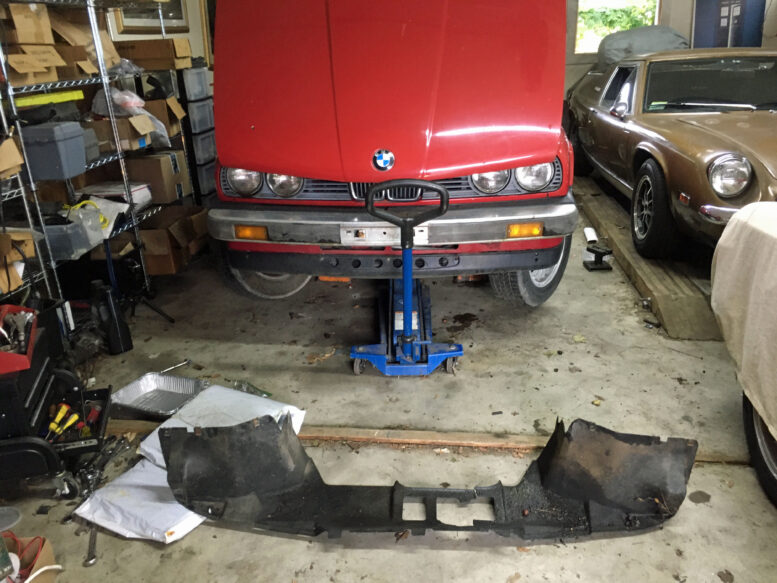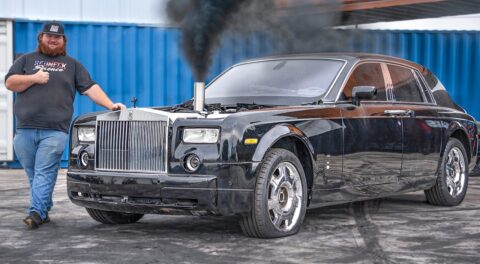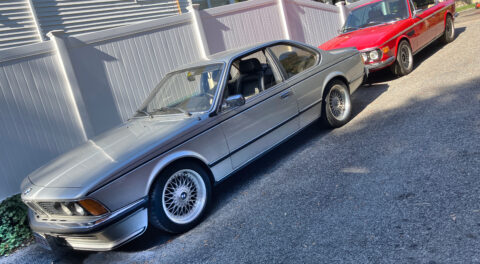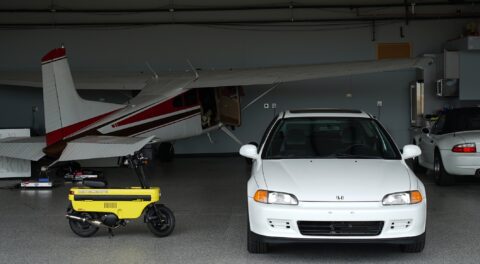When I bought the rust-free rebuilt-salvage-titled 1988 325is last week and titled the piece “The Surprising E30,” I was talking about good surprises. I literally said that The Automotive Powers That Be seemed to be channeling my wishes.
I had no idea how, uh, surprising it would continue be.
Because the previous owner said that the timing belt was last replaced when he bought the car in 2001, the E30 went straight into the garage, where I immediately prepared to replace the belt and water pump. Well, okay—I stopped in the driveway and unloaded a can of foaming Gunk onto the engine compartment to at least make a start on the cleaning that would accompany the work.

Before…

…and after.
The surprises began with a literal trickle. While I was underneath the car disconnecting the lower radiator hose, I saw evidence of all sorts of oil leakage. While that’s part and parcel of any unmaintained older car, there was a curious streak of oil running across the bottom of the pan. I wiped it off and watched it, and saw that it was emanating from a small divot in the pan itself. I had to admit that in the middle of the divot is a hairline crack. So, yeah, the pan is cracked. I drained the oil and resolved that I’d try burning out the oil in the crack with a propane torch, then patching it with J-B Weld, as I did when the upper corner of the head on my 2002tii was cracked and dripping oil onto the exhaust manifold.
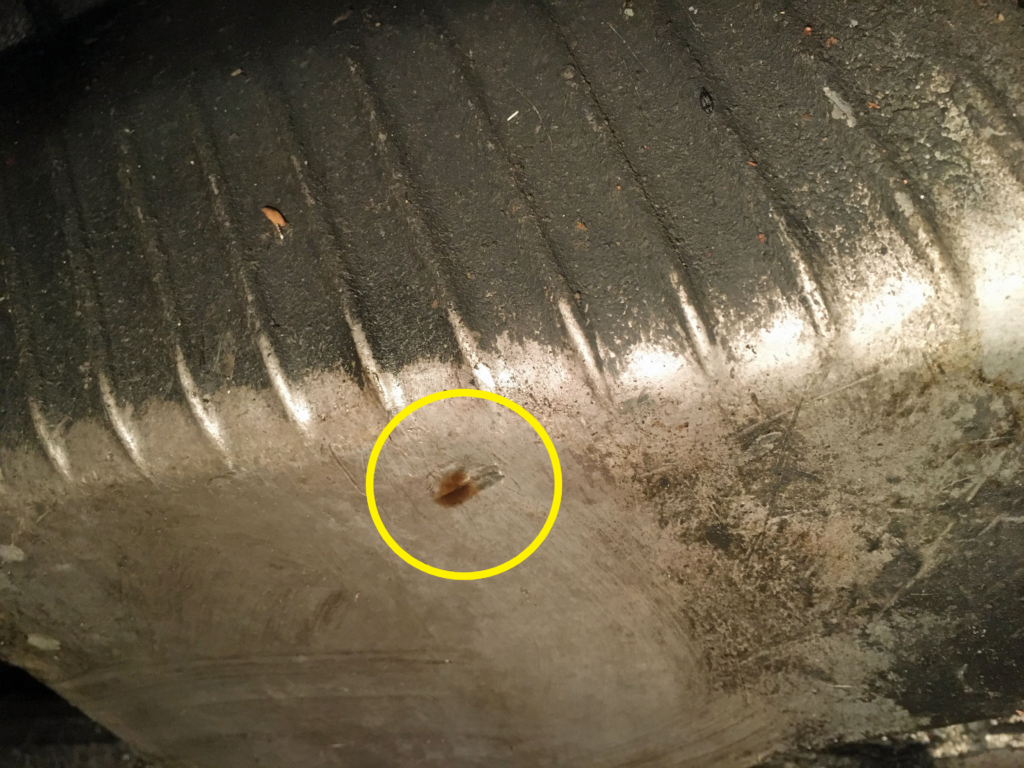
Well, damn.
Then, when I pulled out the radiator, I saw that the fan had clearly been scraping against it for quite some time. I made a note to check the engine mounts.
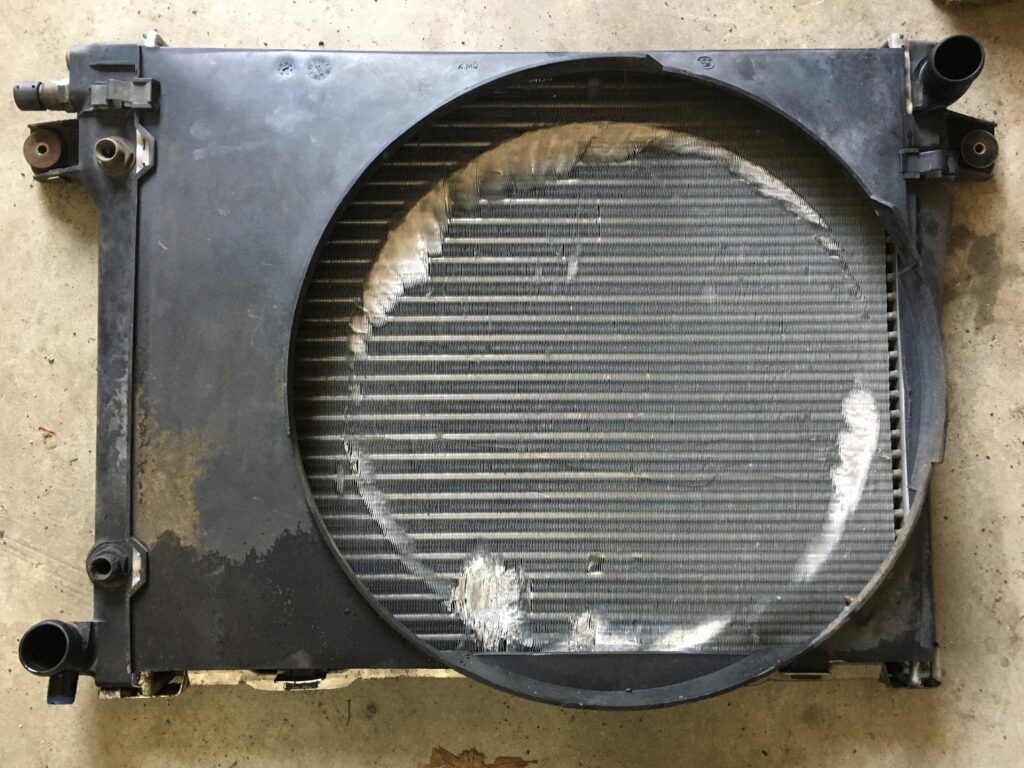
Well, damn again.
I wasn’t thrilled with either of these two developments, but I now look back at the cracked pan and the fan-damaged radiator as the two-day-long sweet spot in my early ownership of the E30 before everything went to hell.
I posted the pic of the fan-mashed radiator to Facebook for laughs, and a couple of folks commented that this is an early radiator that’s no longer available. That prompted E30 stalwarts Ed MacVaugh and Bobbie Morrone to look at the engine compartment pic that shows the expansion tank on the passenger side and question whether this is actually a 1988 E30, since the facelift that occurred in August 1987 included the updated cooling system with a different radiator and the expansion tank on the other side.
That prompted me to take another dive into the VIN. Before I bought the car, I ran the VIN on several decoders, and they showed a build date of 7-29-1987 (the sticker on the door jam rounds it off to 8/87). The CarFax showed the car as an ’88, as did the title. And it has the larger taillights with the horizontal lenses for the back-up lights, and the 3rd brake light, so I had little doubt the car had the facelifted body. But if that was the case, it should have the later cooling system with the crossover pipe and the expansion tank on the driver’s side.
It was Ed MacVaugh who raised the specter that, with the salvage title, I might have a Frankencar on my hands—one where the back of Vehicle A has been spliced with the front Vehicle B. Specifically, Ed said that the placement of the expansion tank wasn’t simply a bolt-on thing—that on the pre-facelifted cars, it’s secured to the passenger-side with two brackets that are welded onto the shock tower (which my car has), and that on later cars, it’s attached to a post on the inner fender on the driver’s side (which it does not).

The taillights and 3rd brake light indicated a facelifted car.
Now, I can instantly spot when a 2002 is a Frankencar (for example, a round tail light car wearing a later nose with black plastic grilles and a one-piece dash and faux wood-grained instrument cluster from a later car), but I’m not an E30 guy. I knew the basics of early cars having big chrome bumpers and low-revving eta engines that transitioned into later cars with small color-keyed bumpers and the high-revving “i” engine, but none of the details. I didn’t know that 1988 is a transitional year in that it has the updated shell with the earlier chrome bumpers attached in a way that they can easily be swapped for the later small color-keyed bumpers. And I didn’t know diddly about the cooling system update. When I looked down on the lower left side of the engine compartment, I saw a curious blocked-off hose. I believe that this is the 3-way hose that’s part of the later cooling system with the expansion tank on the driver’s side. That’s at odds with the fact that the car has the expansion tank mounted on the passenger side.

Plugged up with a security-keyed lug nut so no one can unplug it without the special tool :^) Hey, I’m laughing at it because otherwise the whole thing would make me cry.
So, what is this thing? What did I just buy? I crawled under the nose of the car, looked at the frame legs, and was a bit relieved that didn’t see any obvious big ugly weld demarking where two cars were smushed together.
I looked carefully at the car’s VIN tags. The VIN listed on the sticker on the door jam, the one stamped into the cowl below the right wiper arm, and the ones on the decals on the doors and trunk lid all match the VIN on the title for a 325is built 7-29-87. But the decals on the hood and both front fenders list a VIN that the decoders say is for a 1987 325 with a build date of 2-26. Since the nose of the car isn’t a bolt-on part, I don’t believe it has a VIN tag, but eagle eyes on Facebook tell me that the nose is also from a pre-facelift car.
On the one hand, I screwed up. I bought something I clearly shouldn’t have. Mister “I’m not worried about buying a car with a rebuilt salvage title if it’s rust-free, runs and drives, and is priced right” certainly didn’t expect it to be a Frankencar. But on the other hand, this is how salvage cars are reconstructed. I let it wash over me and decided that it wasn’t that big of a deal. I mean it’s not like it has the 128-hp M20B27 “e” engine from the donor car instead of the original 168-hp M20B25 “i” engine, right?
Wait, it does have the “i” engine, right?
Oh crap.
At first glance, it looks like an “i” engine. The intake manifold tubes are close together instead of having what looks like webbing between fingers as the tubes have on the eta manifold. And it doesn’t have a cold start valve on it like the eta engines do. You can try to deduce things by looking for the “885” stamp on the head indicating an “i” engine (or an 885 head on a 2.7 block indicating a home-built stroker), but when I looked for it, I instead found this:

Oh crap.
I contacted E30 guy Bobbie Morrone, from whom I’d nearly bought a 2002tii last year, and who had commented on the car’s oddness. Bobbie told me that, at least as far as the head was concerned, an examination of the valve train would be definitive because the “e” head has single valve springs and only four cam journals, whereas the 885 “i” head has double valve springs and seven cam journals. I needed to pull the valve cover off anyway to adjust the valves, so in I went. Initially I counted seven journals, but then noticed that only four of them had machined cam surfaces running in them; the other three were empty. This, combined with the head’s single valve springs (and the cast-in tag) sealed it: This was an eta head, and thus likely an eta engine, probably the one from the same car the fenders and hood came from.
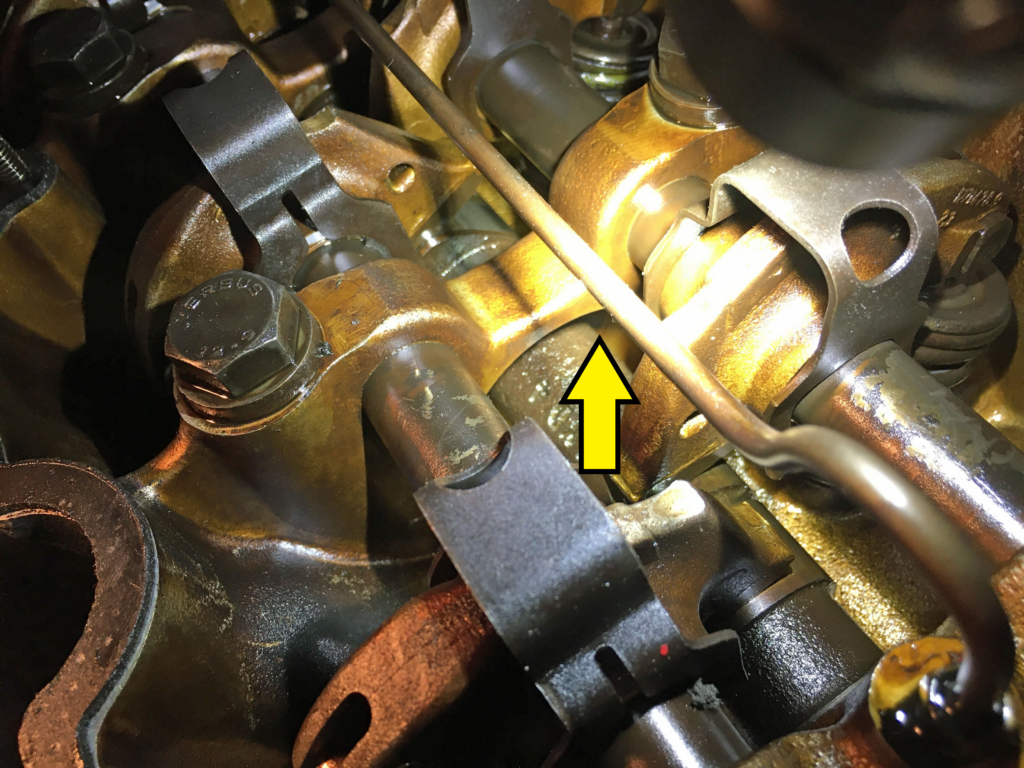
As Bender would say, “and… boned.”
The final bit of engine evidence would be to determine if the block has flat-topped “e” pistons or domed “i” pistons. I have an inexpensive iPhone borescope, but its image quality leaves a lot to be desired. And the “2.7 ETA” stamp on the head is already pretty definitive.
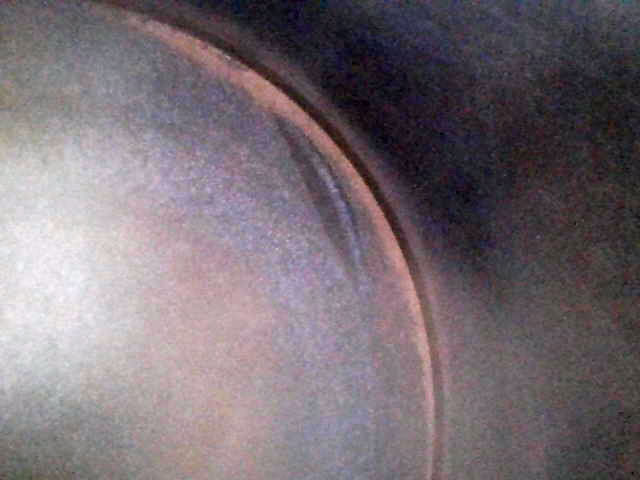
Looks flat-ish to me.
So, the car appears to be a very early facelifted 325is that had a salvage-title-generating event in 1992, and as part of the rebuild, got a graft from an early ’87 325(e) that included the front fenders, the nose, likely the inner fenders, and the m20b27 “e” engine, but for reasons of aesthetics or deception, retained the “i” intake manifold.
Oh, and mice.
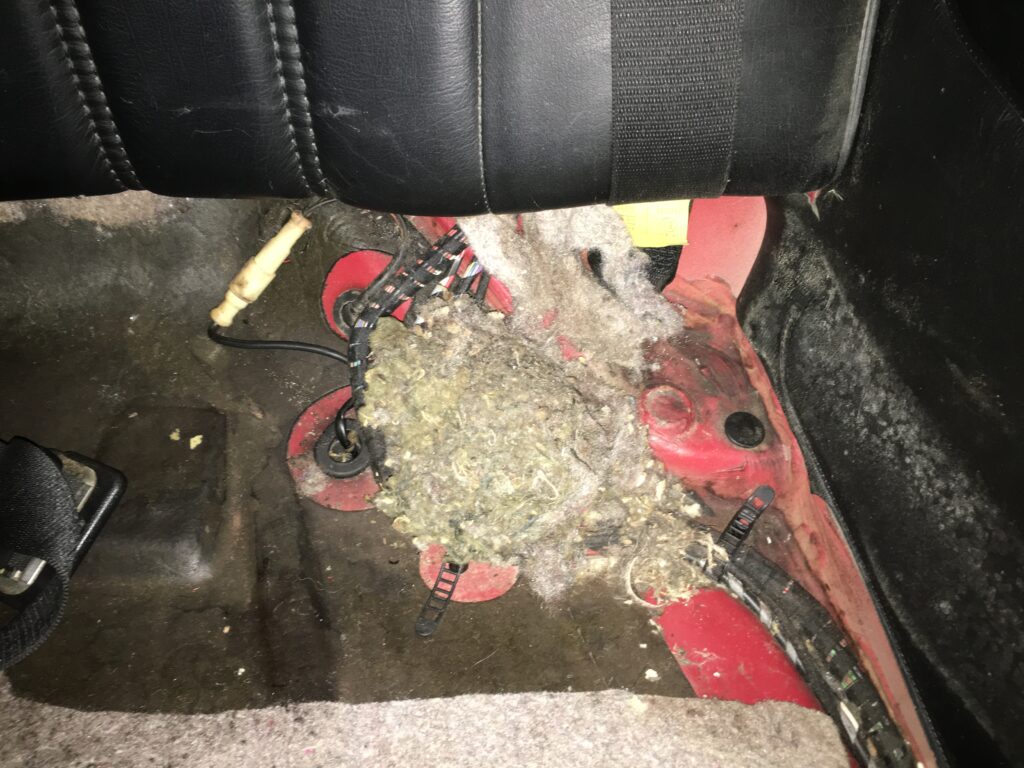
The hits just keep on coming. Along with the smell.
Needless to say, I’m not thrilled about any of this. I have no desire to open the spending taps the way I would if the car wasn’t such an obvious mongrel (I wish it had been obvious to me) whose value will be severely capped whenever I decide to part with it. I’ll replace the timing belt and water pump, as well as the old spark plugs and the torn intake boot. And do the filters. And try to plug the leaky oil pan. Then I’ll probably drop the original fan-damaged radiator back in and drive the car around the neighborhood for a bit on its unsafely-dry-rotted tires to get some sense of what it is and whether we want to live together before I do anything else. Please don’t be the 47th person to cheerfully suggest “Just drop an 885 head on it.” You can make that choice on your own Franken30. I’m highly unlikely to make it on mine.
Automotive Powers That Be, I sincerely apologize for my hubris. I’m not sure I can stand any more surprises.
—Rob Siegel
____________________________________
Rob’s newest book, The Best of The Hack Mechanic, is available here on Amazon, as are his seven other books. Signed copies can be ordered directly from Rob here.
Tags: 2.7 ETA crap Frankencar

